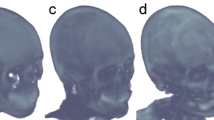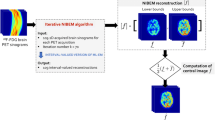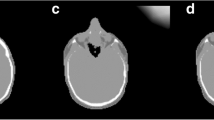Abstract
Objective
One of the main challenges of integrated PET/MR is to achieve an accurate PET attenuation correction (AC), especially in brain acquisition. Here, we evaluated an AC method based on zero echo time (ZTE) MRI, comparing it with the single-atlas AC method and CT-based AC, set as reference.
Methods
Fifty patients (70 ± 11 years old, 28 men) underwent FDG-PET/MR examination (SIGNA PET/MR 3.0 T, GE Healthcare) as part of the investigation of suspected dementia. They all had brain computed tomography (CT), 2-point LAVA-flex MRI (for atlas-based AC), and ZTE-MRI. Two AC methods were compared with CT-based AC (CTAC): one based on a single atlas, one based on ZTE segmentation. Impact on brain metabolism was evaluated using voxel and volumes of interest–based analyses. The impact of AC was also evaluated through comparisons between two subgroups of patients extracted from the whole population: 15 patients with mild cognitive impairment and normal metabolic pattern, and 22 others with metabolic pattern suggestive of Alzheimer disease, using SPM12 software.
Results
ZTE-AC yielded a lower bias (3.6 ± 3.2%) than the atlas method (4.5 ± 6.1%) and lowest interindividual (4.6% versus 6.8%) and inter-regional (1.4% versus 2.6%) variabilities. Atlas-AC resulted in metabolism overestimation in cortical regions near the vertex and cerebellum underestimation. ZTE-AC yielded a moderate metabolic underestimation mainly in the occipital cortex and cerebellum. Voxel-wise comparison between the two subgroups of patients showed that significant difference clusters had a slightly smaller size but similar locations with PET images corrected with ZTE-AC compared with those corrected with CT, whereas atlas-AC images showed a notable reduction of significant voxels.
Conclusion
ZTE-AC performed better than atlas-AC in detecting pathologic areas in suspected neurodegenerative dementia.
Key Points
• The ZTE-based AC improved the accuracy of the metabolism quantification in PET compared with the atlas-AC method.
• The overall uptake bias was 21% lower when using ZTE-based AC compared with the atlas-AC method.
• ZTE-AC performed better than atlas-AC in detecting pathologic areas in suspected neurodegenerative dementia.




Similar content being viewed by others
Abbreviations
- AAL:
-
Automated anatomical labeling
- AC:
-
Attenuation correction
- AC-PC line:
-
Anterior commissure–posterior commissure line
- AD:
-
Alzheimer disease
- CNN:
-
Convolutional neural networks
- DL:
-
Deep learning
- FDG:
-
2-Fluoro-2-deoxy-d-glucose
- FWE:
-
Family-wise error
- HU:
-
Hounsfield unit
- MNI:
-
Montreal Neurological Institute
- MR:
-
Magnetic resonance
- MRAC:
-
Magnetic resonance–based attenuation correction
- MRI:
-
Magnetic resonance imaging
- PET:
-
Positron emission tomography
- PSF:
-
Point spread function
- SPM:
-
Statistical parametric mapping
- SUV:
-
Standard uptake value
- TOF:
-
Time of flight
- UTE:
-
Ultrashort time
- ZTE:
-
Zero time echo
References
Barthel H, Schroeter ML, Hoffmann K-T, Sabri O (2015) PET/MR in dementia and other neurodegenerative diseases. Semin Nucl Med 45:224–233. https://doi.org/10.1053/j.semnuclmed.2014.12.003
Ladefoged CN, Law I, Anazodo U et al (2017) A multi-centre evaluation of eleven clinically feasible brain PET/MRI attenuation correction techniques using a large cohort of patients. Neuroimage 147:346–359. https://doi.org/10.1016/j.neuroimage.2016.12.010
Sekine T, Buck A, Delso G et al (2015) Evaluation of atlas-based attenuation correction for integrated PET/MR in human brain – application of a head atlas and comparison to true CT-based attenuation correction. J Nucl Med 57:215–220. https://doi.org/10.2967/jnumed.115.159228
Burgos N, Cardoso MJ, Thielemans K et al (2014) Attenuation correction synthesis for hybrid PET-MR scanners: application to brain studies. IEEE Trans Med Imaging 33:2332–2341. https://doi.org/10.1109/TMI.2014.2340135
Sekine T, Burgos N, Warnock G et al (2016) Multi atlas-based attenuation correction for brain FDG-PET imaging using a TOF-PET/MR scanner– comparison with clinical single atlas- and CT-based attenuation correction. J Nucl Med 57:1258–1264. https://doi.org/10.2967/jnumed.115.169045
Khalifé M, Fernandez B, Jaubert O et al (2017) Subject-specific bone attenuation correction for brain PET/MR: can ZTE-MRI substitute CT scan accurately? Phys Med Biol 62:7814–7832. https://doi.org/10.1088/1361-6560/aa8851
Delso G, Kemp B, Kaushik S et al (2018) Improving PET/MR brain quantitation with template-enhanced ZTE. NeuroImage 181:403–413. https://doi.org/10.1016/j.neuroimage.2018.07.029
Delso G, Kemp B, Kaushik S, Wiesinger F, Sekine T (2015) Clinical evaluation of zero-echo-time MR imaging for the segmentation of the skull. J Nucl Med 56:417–422. https://doi.org/10.2967/jnumed.114.149997
Sekine T, Ter Voert EE, Warnock G et al (2016) Clinical evaluation of zero-echo-time attenuation correction for brain 18F-FDG PET/MRI: comparison with atlas attenuation correction. J Nucl Med 57:1927–1932. https://doi.org/10.2967/jnumed.116.175398
Wollenweber SD, Ambwani S, Delso G et al (2013) Evaluation of an atlas-based PET head attenuation correction using PET/CT amp; MR patient data. IEEE Trans Nucl Sci 60:3383–3390. https://doi.org/10.1109/TNS.2013.2273417
Wiesinger F, Sacolick LI, Menini A et al (2016) Zero TE MR bone imaging in the head. Magn Reson Med 75:107–114. https://doi.org/10.1002/mrm.25545
Delso G, Fernandez B, Wiesingern F, Jian Y, Bobb C, Jansen FP (2017) Repeatability of ZTE bone maps of the head. IEEE Transactions on Radiation and Plasma Medical Sciences pp 1-1
Yang J, Wiesinger F, Kaushik S et al (2017) Evaluation of sinus/edge-corrected zero-echo-time-based attenuation correction in brain PET/MRI. J Nucl Med 58:1873–1879. https://doi.org/10.2967/jnumed.116.188268
Tustison NJ, Avants BB, Cook PA et al (2010) N4ITK: improved N3 bias correction. IEEE Trans Med Imaging 29:1310–1320. https://doi.org/10.1109/TMI.2010.2046908
Wiesinger F, Bylund M, Yang J et al (2018) Zero TE-based pseudo-CT image conversion in the head and its application in PET/MR attenuation correction and MR-guided radiation therapy planning. Magn Reson Med. https://doi.org/10.1002/mrm.27134
Jenkinson M, Smith S (2001) A global optimisation method for robust affine registration of brain images. Med Image Anal 5:143–156
Burger C, Goerres G, Schoenes S, Buck A, Lonn AH, Von Schulthess GK (2002) PET attenuation coefficients from CT images: experimental evaluation of the transformation of CT into PET 511-keV attenuation coefficients. Eur J Nucl Med Mol Imaging 29:922–927. https://doi.org/10.1007/s00259-002-0796-3
Carney JPJ, Townsend DW, Rappoport V, Bendriem B (2006) Method for transforming CT images for attenuation correction in PET/CT imaging. Med Phys 33:976–983. https://doi.org/10.1118/1.2174132
Alessio AM, Kinahan PE, Cheng PM, Vesselle H, Karp J (2004) PET/CT scanner instrumentation, challenges, and solutions. Radiol Clin North Am 42:1017–1032, vii. https://doi.org/10.1016/j.rcl.2004.08.001
Zhang B, Pal D, Hu Z et al (2009) Attenuation correction for MR table and coils for a sequential PET/MR system. In: 2009 IEEE Nuclear Science Symposium Conference Record (NSS/MIC). pp 3303–3306
Eldib M, Bini J, Faul DD, Oesingmann N, Tsoumpas C, Fayad ZA (2016) Attenuation correction for MR coils in combined PET/MR imaging: a review. PET Clin 11:151–160. https://doi.org/10.1016/j.cpet.2015.10.004
Yakushev I, Landvogt C, Buchholz HG et al (2008) Choice of reference area in studies of Alzheimer’s disease using positron emission tomography with fluorodeoxyglucose-F18. Psychiatry Res 164:143–153. https://doi.org/10.1016/j.pscychresns.2007.11.004
Tzourio-Mazoyer N, Landeau B, Papathanassiou D et al (2002) Automated anatomical labeling of activations in SPM using a macroscopic anatomical parcellation of the MNI MRI single-subject brain. NeuroImage 15:273–289. https://doi.org/10.1006/nimg.2001.0978
Sousa JM, Appel L, Engström M et al (2018) Evaluation of zero-echo-time attenuation correction for integrated PET/MR brain imaging-comparison to head atlas and 68Ge-transmission-based attenuation correction. EJNMMI Phys 5:20. https://doi.org/10.1186/s40658-018-0220-0
Rezaei A, Schramm G, Willekens SMA, Delso G, Van Laere K, Nuyts J (2019) A quantitative evaluation of joint activity and attenuation reconstruction in TOF-PET/MR brain imaging. J Nucl Med. https://doi.org/10.2967/jnumed.118.220871
Leynes AP, Yang J, Wiesinger F et al (2017) Direct PseudoCT generation for pelvis PET/MRI attenuation correction using deep convolutional neural networks with multi-parametric MRI: zero echo-time and Dixon deep pseudoCT (ZeDD-CT). J Nucl Med 57:jnumed.117.198051. https://doi.org/10.2967/jnumed.117.198051
Arabi H, Zeng G, Zheng G, Zaidi H (2019) Novel adversarial semantic structure deep learning for MRI-guided attenuation correction in brain PET/MRI. Eur J Nucl Med Mol Imaging. https://doi.org/10.1007/s00259-019-04380-x
Hwang D, Kim KY, Kang SK et al (2018) Improving the accuracy of simultaneously reconstructed activity and attenuation maps using deep learning. J Nucl Med 59:1624–1629. https://doi.org/10.2967/jnumed.117.202317
Ladefoged CN, Marner L, Hindsholm A, Law I, Højgaard L, Andersen FL (2019) Deep learning based attenuation correction of PET/MRI in pediatric brain tumor patients: evaluation in a clinical setting. Front Neurosci:12. https://doi.org/10.3389/fnins.2018.01005
Acknowledgements
The authors would like to thank GE Healthcare for providing access to research tools and prototype pulse sequences.
The authors also would like to thank ARC foundation which allowed Dr. SGARD to get a fellowship for a year of research during which he was able to carry out this study.
Funding
The authors state that this work has not received any funding.
Author information
Authors and Affiliations
Corresponding author
Ethics declarations
Guarantor
The scientific guarantor of this publication is Aurélie Kas, MD, PhD, Department of Nuclear Medicine, Pitié-Salpêtrière C. Foix Hospital, APHP, Paris, France. Phone: 33 1 42 17 62 80. Fax: 33 1 42 17 62 92. Email: aurelie.kas@gmail.com
Conflict of interest
The authors of this manuscript declare relationships with the following companies:
Maya Khalifé received a research grant from GE Healthcare.
Brice Fernandez and Gaspar Delso are GE Healthcare employees. Only non-GE employees had control of inclusion of data and information that might present a conflict of interest for authors who are employees of GE Healthcare. No other potential conflict of interest relevant to this article was reported.
Aurélie Kas received honoria for lectures from GE Healthcare and Piramal.
Marie-Odile Habert received honoraria for lectures from Lilly.
Statistics and biometry
One of the authors has significant statistical expertise.
No complex statistical methods were necessary for this paper.
Informed consent
Written informed consent was obtained from all subjects (patients) in this study.
Ethical approval
Data of this study were extracted from the PET/MR examinations database of the Pitié-Salpêtrière Hospital, Paris, France, which was approved by the French authority for the protection of privacy and personal data in clinical research (CNIL, approval no. 2111722). All procedures performed in this study were in accordance with the ethical standards of the institutional research committee and with the 1964 Helsinki Declaration and its later amendments.
Methodology
• Retrospective
• Experimental
• Performed at one institution
Additional information
Publisher’s note
Springer Nature remains neutral with regard to jurisdictional claims in published maps and institutional affiliations.
Electronic supplementary material
ESM 1
(DOCX 119 kb)
Rights and permissions
About this article
Cite this article
Sgard, B., Khalifé, M., Bouchut, A. et al. ZTE MR-based attenuation correction in brain FDG-PET/MR: performance in patients with cognitive impairment. Eur Radiol 30, 1770–1779 (2020). https://doi.org/10.1007/s00330-019-06514-z
Received:
Revised:
Accepted:
Published:
Issue Date:
DOI: https://doi.org/10.1007/s00330-019-06514-z




